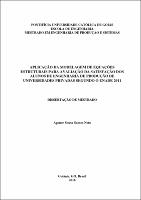| Compartilhamento |


|
Use este identificador para citar ou linkar para este item:
http://tede2.pucgoias.edu.br:8080/handle/tede/2480Registro completo de metadados
| Campo DC | Valor | Idioma |
|---|---|---|
| dc.creator | Santos Neto, Agenor Sousa | - |
| dc.creator.Lattes | http://lattes.cnpq.br/6615964725213306 | por |
| dc.contributor.advisor1 | Dantas, Maria José Pereira | - |
| dc.contributor.advisor1Lattes | http://lattes.cnpq.br/5115002204148904 | por |
| dc.contributor.referee1 | Soares, Júlio Cesar Valandro | - |
| dc.contributor.referee1Lattes | http://lattes.cnpq.br/9557844115914458 | por |
| dc.contributor.referee2 | Machado, Ricardo Luiz | - |
| dc.contributor.referee2Lattes | http://lattes.cnpq.br/5565450268864826 | por |
| dc.date.accessioned | 2016-08-10T10:40:35Z | - |
| dc.date.available | 2016-04-05 | - |
| dc.date.issued | 2016-03-02 | - |
| dc.identifier.citation | SANTOS NETO, Agenor Sousa. APPLICATION OF STRUCTURAL EQUATION MODELING TO ASSESS THE SATISFACTION OF STUDENTS OF PRODUCTION ENGINEERING OF PRIVATE UNIVERSITIES SECOND ENADE 2011. 2016. 216 f. Dissertação (Mestrado em Engenharia) - Pontifícia Universidade Católica de Goiás, GOIÂNIA, 2016. | por |
| dc.identifier.uri | http://localhost:8080/tede/handle/tede/2480 | - |
| dc.description.resumo | Averiguar a satisfação de alunos quanto ao curso é essencial para as instituições de educação, pois proporciona uma reflexão sobre os métodos didáticos empregados, bem como fornece subsídios para a melhoria da qualidade do ensino dos cursos oferecidos pela instituição. Partindo dessa premissa, a presente pesquisa buscou validar um modelo para avaliação da satisfação dos alunos dos cursos de Engenharia de Produção de Instituições de Ensino Superior Privadas. Foi utilizado como instrumento de pesquisa o Questionário do Estudante do Enade 2011, resultando em um número total de entrevistas válidas de 1790. As perguntas do Questionário do Estudante foram agrupadas segundo o modelo de Paswan e Young (2002) e Vieira, Milach e Huppes (2008) para pesquisa sobre satisfação geral em alunos de graduação, utilizados os seguintes construtos: Envolvimento do Professor, Interesse do Estudante, Demandas do Curso, Organização do Curso e Satisfação Geral. Além disso, foi acrescentado um novo construto nesta pesquisa, Infraestrutura. A Análise Fatorial Confirmatória e a Modelagem de Equações Estruturais foram utilizadas como métodos para avaliação das notas dadas pelos alunos às variáveis que compõem a satisfação em relação ao serviço prestado pela instituição de ensino. O software SPSS® (Statistical Package for the Social Sciences) e seu módulo AMOS® apoiaram a análise dos dados. De oito hipóteses estabelecidas inicialmente, três delas foram aceitas. Essas hipóteses indicaram que o construto Envolvimento do Professor é elemento fundamental para alcançar a Satisfação Geral do aluno. | por |
| dc.description.abstract | Ascertain the satisfaction of students regarding the course is essential to the educational institutions, as it provides a reflection on the teaching methods employed, as well as provides grants for improving the quality of teaching of the courses offered by the institution. Starting from this premise, the present research sought to validate a model for the evaluation of the satisfaction of the students of Industrial Engineering courses of Private Higher Education Institutions. It was used as an instrument of the research the Student Questionnaire of the Enade 2011, resulting in a total number of valid interviews of 1790. The Student Questionnaire questions were grouped according to the model of Paswan and Young (2002) and Vieira, Milach and Huppes (2008) for general satisfaction survey on undergraduates, used the following constructs: Involvement of Teacher, Student Interest, Demands of the Course, Course Organization and Overall Satisfaction. In addition, was added a new construct in this research, Infrastructure. The Confirmatory Factor Analysis and Structural Equation Modeling were used as methods for evaluation of notes given by students the variables that compose the satisfaction in relation to the service provided by the educational institution. The software SPSS (Statistical Package for the Social Sciences) e and its module AMOS® supported the analysis of the data. Eight hypotheses were established initially, three of them were accepted. These assumptions have indicated that the construct Involvement of Teacher is fundamental to achieve the overall satisfaction of the student. | eng |
| dc.description.provenance | Made available in DSpace on 2016-08-10T10:40:35Z (GMT). No. of bitstreams: 1 Agenor Sousa Santos Neto.pdf: 2851103 bytes, checksum: 9d039bcb1516e87ab2f51e86debac865 (MD5) Previous issue date: 2016-03-02 | eng |
| dc.format | application/pdf | por |
| dc.thumbnail.url | http://localhost:8080/tede/retrieve/8353/Agenor%20Sousa%20Santos%20Neto.pdf.jpg | * |
| dc.language | por | por |
| dc.publisher | Pontifícia Universidade Católica de Goiás | por |
| dc.publisher.department | Engenharia | por |
| dc.publisher.country | BR | por |
| dc.publisher.initials | PUC Goiás | por |
| dc.publisher.program | Engenharia de Produção e Sistemas | por |
| dc.rights | Acesso Aberto | por |
| dc.subject | Satisfação dos Alunos | por |
| dc.subject | Engenharia de Produção | por |
| dc.subject | Instituições de Ensino Superior Privadas | por |
| dc.subject | Enade 2011 | por |
| dc.subject | Modelagem de Equações Estruturais. | por |
| dc.subject | Satisfaction of Students | eng |
| dc.subject | Industrial Engineering | eng |
| dc.subject | Private Higher Education Institutions | eng |
| dc.subject | Enade 2011 | eng |
| dc.subject | Structural Equation Modeling | eng |
| dc.subject.cnpq | CNPQ::ENGENHARIAS::ENGENHARIA DE PRODUCAO | por |
| dc.title | APLICAÇÃO DA MODELAGEM DE EQUAÇÕES ESTRUTURAIS PARA AVALIAÇÃO DA SATISFAÇÃO DOS ALUNOS DE ENGENHARIA DE PRODUÇÃO DE UNIVERSIDADES PRIVADAS SEGUNDO O ENADE 2011. | por |
| dc.title.alternative | APPLICATION OF STRUCTURAL EQUATION MODELING TO ASSESS THE SATISFACTION OF STUDENTS OF PRODUCTION ENGINEERING OF PRIVATE UNIVERSITIES SECOND ENADE 2011 | eng |
| dc.type | Dissertação | por |
| Aparece nas coleções: | Mestrado em Engenharia de Produção e Sistemas | |
Arquivos associados a este item:
| Arquivo | Descrição | Tamanho | Formato | |
|---|---|---|---|---|
| Agenor Sousa Santos Neto.pdf | 2,78 MB | Adobe PDF |  Baixar/Abrir Pré-Visualizar |
Os itens no repositório estão protegidos por copyright, com todos os direitos reservados, salvo quando é indicado o contrário.




